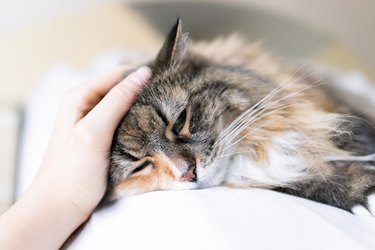
When you own a cat, you'll learn about all sorts of health issues that cats may encounter. Topics like hairballs, injured paws, and even skin sensitivities are all pretty common. You will probably hear about some of the more common ailments your cat might develop, like an injured paw or hairball issues. Hopefully your cat will have a long, healthy life with minimal injuries and issues. But, if your cat ever experiences an internal injury, anal prolapse, or other serious health issue, then recognizing the issue and acting quickly can help to get your cat feeling better quickly.
Understanding cat rectal prolapse
Video of the Day
If your cat has developed a rectal prolapse, you may notice tissue that is protruding from your cat's rectum. According to Merck Veterinary Manual, rectal prolapse involves all of the rectum layers and the rectal lining, which then protrudes through the anus. Protruding anus in cats, also known as an anal prolapse, can be a bit more minor, involving just the rectal lining.
Video of the Day
Both rectal prolapse and anal prolapse are serious conditions and require veterinary treatment to correct.
Causes of anal prolapse
Merck Veterinary Manual states that anal and rectal prolapse can affect cats of any breed, age, or sex. However, it's most common for these conditions to occur in young cats. Cats who have severe diarrhea, or who often strain to defecate, are more likely to develop rectal prolapse.
According to Pet MD, there are a few other causes of a cat with a prolapsed rectum. Digestive system disorders, internal parasites, inflammation of the small or large intestines, and urinary stones can all cause a prolapsed rectum. Additionally, rectal or anal tumors can cause this condition.
Diagnosing the issue
Pet MD explains that your veterinarian will likely perform some different tests to both diagnose an anal or rectal prolapse, as well as to determine the cause of the issue. Your vet will begin with a complete physical exam, and will likely run a chemical blood profile and complete blood count to look for infection and other abnormalities.
Next, your vet may test a stool sample to see if your cat has internal parasites. X-rays or ultrasounds of your cat's abdomen may be necessary to look for kidney stones, bladder wall thickening, and other issues.
Lastly, your vet will examine your cat's rectum to look for tissue that may be displaced, damaged, or dead. This tissue will need to be removed.
Treating rectal prolapse
According to Pet MD, your vet will need to treat any infections or other causes behind the prolapse before addressing the prolapse itself. Your vet will work to reduce the swelling and replace the tissue inside your cat's anus.
Depending on the severity of the prolapse, your vet may be able to gently massage the area and replace the tissue that way. In some cases, your vet may anesthetize your cat to relieve pain before attempting to replace the issue. He may use lubricating gels to help reduce swelling and make the process easier.
Once the tissue is back in place, your vet may choose to stitch the tissue in place to keep it from being pushed out again. He will probably prescribe stool softeners for your cat as she recovers.
If the prolapse has originated deep within your cat's rectal canal, then your cat may need to undergo more involved surgery.
Home care
According to Pet MD, when you're able to bring your cat home, you will need to follow your vet's instructions carefully and watch for signs that the prolapse has recurred. It's possible for the surgery site to split and reopen during the first five-to-seven days after surgery.
Merck Veterinary Manual suggests that a moist diet may help your cat to have easier bowel movements as he recovers. If your cat has diarrhea after the surgery, you should contact your vet right away, since additional treatment may be necessary.
Always check with your veterinarian before changing your pet’s diet, medication, or physical activity routines. This information is not a substitute for a vet’s opinion.